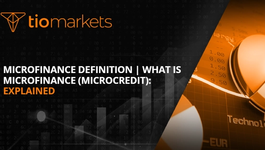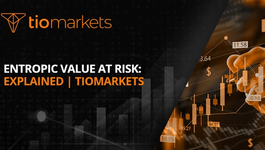Yield Farming and Liquidity Mining: Maximizing Returns in DeFi
BY TIOmarkets
|May 23, 2024Cryptocurrency has revolutionized the financial world, providing decentralized solutions to traditional banking. In this ever-evolving landscape, two strategies have gained significant attention: yield farming and liquidity mining. These approaches allow crypto enthusiasts to maximize their returns while participating in the decentralized finance, or DeFi, ecosystem.
Understanding the Basics of DeFi
If you are new to the world of cryptocurrencies and DeFi, let's start with the basics. DeFi, short for decentralized finance, refers to a set of financial applications built on blockchain technology. Unlike traditional financial institutions, DeFi aims to remove intermediaries and provide a transparent and accessible financial ecosystem for everyone.
As the DeFi space continues to evolve rapidly, it has garnered significant attention from both investors and developers. The decentralized nature of DeFi platforms offers users greater control over their assets and financial activities, fostering a sense of empowerment and autonomy in the digital financial realm.
What is DeFi?
DeFi encompasses a wide range of financial services, including lending, borrowing, staking, and trading, all carried out using smart contracts on the blockchain. These decentralized applications, or dApps, are built on public blockchains like Ethereum, allowing users to interact with the protocols and trade digital assets without relying on intermediaries.
One of the key advantages of DeFi is its ability to provide financial services to individuals who are underserved or excluded by traditional banking systems. By leveraging blockchain technology, DeFi opens up new opportunities for financial inclusion and innovation, potentially revolutionizing the way we think about money and banking.
Key Components of DeFi
DeFi relies on several key components, such as smart contracts, decentralized exchanges (DEXs), and decentralized autonomous organizations (DAOs). Smart contracts are self-executing contracts with the terms of the agreement directly written into code. DEXs enable peer-to-peer trading of cryptocurrencies, eliminating the need for centralized exchanges. DAOs are organizations run by smart contracts, making decisions through community voting.
Furthermore, the composability of DeFi protocols allows developers to create new financial products and services by combining existing building blocks. This modular approach to DeFi development fosters innovation and experimentation within the ecosystem, leading to the rapid expansion of decentralized finance applications and use cases.
Introduction to Yield Farming
Yield farming has gained immense popularity within the DeFi ecosystem as it allows users to earn passive income by lending or providing liquidity to decentralized protocols. But what exactly is yield farming?
Yield farming, also known as liquidity mining, is a practice where cryptocurrency holders provide liquidity to decentralized finance (DeFi) protocols in exchange for rewards. This process involves users lending their crypto assets to pools that are used to facilitate various transactions on DeFi platforms. Yield farming has revolutionized the way individuals interact with digital assets, offering them the opportunity to earn additional tokens while contributing to the liquidity of the ecosystem.
The Concept of Yield Farming
Yield farming, also known as liquidity mining, involves depositing funds into decentralized protocols and earning rewards for doing so. By providing liquidity, users enable the smooth functioning of DeFi platforms while earning additional tokens as incentives. These incentives come in the form of governance tokens or a share of transaction fees generated through the protocol.
Participating in yield farming requires users to lock up their assets in smart contracts, which are self-executing contracts with the terms of the agreement directly written into code. These smart contracts automatically execute actions when predetermined conditions are met, ensuring that users receive their rewards seamlessly. The concept of yield farming has introduced a new way for crypto enthusiasts to engage with DeFi projects and be actively involved in the governance and decision-making processes of these platforms.
How Does Yield Farming Work?
Yield farmers allocate their assets to liquidity pools, which are used to facilitate transactions within DeFi protocols. In return, farmers receive rewards proportional to the amount of liquidity they provide. It's important to note that yield farming comes with risks due to market volatility and potential smart contract vulnerabilities. However, diligent research and risk management practices can help mitigate these risks.
Furthermore, yield farming has led to the rise of decentralized autonomous organizations (DAOs), which are entities governed by smart contracts and community voting. DAOs play a crucial role in the distribution of governance tokens to yield farmers, giving them a voice in the decision-making processes of DeFi platforms. This innovative approach to incentivizing participation has fostered a sense of community and collaboration within the DeFi space, driving further adoption and development of decentralized applications.
Delving into Liquidity Mining
Liquidity mining is a specific form of yield farming that focuses on providing liquidity to decentralized exchanges. Let's explore this strategy in more detail.
When delving into the world of liquidity mining, it's essential to understand the underlying mechanics that drive this innovative concept. By actively participating in liquidity mining, users not only contribute to the efficient functioning of decentralized exchanges but also stand to benefit from attractive rewards in the form of native tokens.
Liquidity Mining Explained
Liquidity mining involves incentivizing users to deposit their assets into liquidity pools that facilitate trading on DEXs. As liquidity providers, users earn rewards in the form of the platform's native tokens. These tokens play a crucial role within the ecosystem, granting holders voting rights and various privileges.
Moreover, liquidity mining serves as a mechanism to bootstrap liquidity for new projects and incentivize users to engage with these platforms actively. By fostering a vibrant ecosystem of liquidity providers, decentralized exchanges can enhance trading volumes and overall user experience.
The Process of Liquidity Mining
To participate in liquidity mining, users need to provide both a base cryptocurrency and a stablecoin into the liquidity pool. The ratio of the two assets provided determines the initial price of the liquidity pool tokens. As these tokens are traded, the pool continually rebalances to ensure price stability. Users earn rewards based on the amount of liquidity they provide and the duration of their participation.
Additionally, the process of liquidity mining involves a dynamic interplay between market forces and user engagement. By strategically allocating assets to liquidity pools, participants can optimize their yield and actively contribute to the growth of decentralized finance ecosystems.
Comparing Yield Farming and Liquidity Mining
While both yield farming and liquidity mining aim to maximize returns within the DeFi space, there are key differences between the two strategies.
Similarities and Differences
Yield farming and liquidity mining both involve providing liquidity to DeFi protocols to earn rewards. However, yield farming encompasses a broader range of strategies, including lending, borrowing, and staking, while liquidity mining specifically refers to providing liquidity for trading on DEXs. It's crucial to evaluate the risks and rewards associated with each strategy before deciding which one aligns with your investment goals.
Choosing Between Yield Farming and Liquidity Mining
The choice between yield farming and liquidity mining depends on various factors, including risk tolerance, time commitment, and financial goals. Some investors may prefer the simplicity and lower risk associated with liquidity mining, while others might be willing to explore more complex yield farming strategies to potentially achieve higher returns. It's essential to conduct thorough research, understand the protocols involved, and evaluate the associated risks before committing your funds.
Strategies to Maximize Returns in DeFi
Now that we have explored the basics of yield farming and liquidity mining, let's discuss some effective strategies to maximize returns in the DeFi space.
Effective Yield Farming Strategies
One popular yield farming strategy is known as "farming and compounding." This involves reinvesting the earned rewards back into the same protocol or diversifying across multiple protocols to compound the returns. Additionally, users can explore strategies like staking liquidity pool tokens or participating in liquidity mining pools that offer attractive rewards.
Successful Liquidity Mining Techniques
Successful liquidity mining techniques involve finding platforms with high demand for liquidity, low competition, and sustainable reward mechanisms. It's crucial to monitor market conditions, assess the credibility of the protocols, and consider the overall potential returns before deciding to participate in a liquidity mining campaign.
In conclusion, yield farming and liquidity mining provide opportunities for crypto enthusiasts to maximize their returns in the DeFi space. By understanding the basics of DeFi, the concept and process of yield farming, and the specifics of liquidity mining, investors can make informed decisions. Remember, conducting thorough research, managing risks, and staying up-to-date with the market are key to succeeding in these strategies. Happy farming!
Take Your Trading to the Next Level with TIOmarkets
Ready to apply your DeFi knowledge to the broader markets? TIOmarkets, a top rated forex broker, invites you to expand your trading horizons. With over 170,000 accounts opened in more than 170 countries, our platform offers you the opportunity to trade 300+ instruments across 5 markets, including Forex, indices, stocks, commodities, and futures, all with low fees. Enhance your trading skills with our comprehensive suite of educational resources and step-by-step guides. Don't miss out on the chance to elevate your trading experience. Create a Trading Account today and join a community of successful traders!

Risk disclaimer: CFDs are complex instruments and come with a high risk of losing money rapidly due to leverage. You should consider whether you understand how CFDs work and whether you can afford to take the high risk of losing your money. Never deposit more than you are prepared to lose. Professional client’s losses can exceed their deposit. Please see our risk warning policy and seek independent professional advice if you do not fully understand. This information is not directed or intended for distribution to or use by residents of certain countries/jurisdictions including, but not limited to, USA & OFAC. The Company holds the right to alter the aforementioned list of countries at its own discretion.
Join us on social media

Behind every blog post lies the combined experience of the people working at TIOmarkets. We are a team of dedicated industry professionals and financial markets enthusiasts committed to providing you with trading education and financial markets commentary. Our goal is to help empower you with the knowledge you need to trade in the markets effectively.
Related Posts





